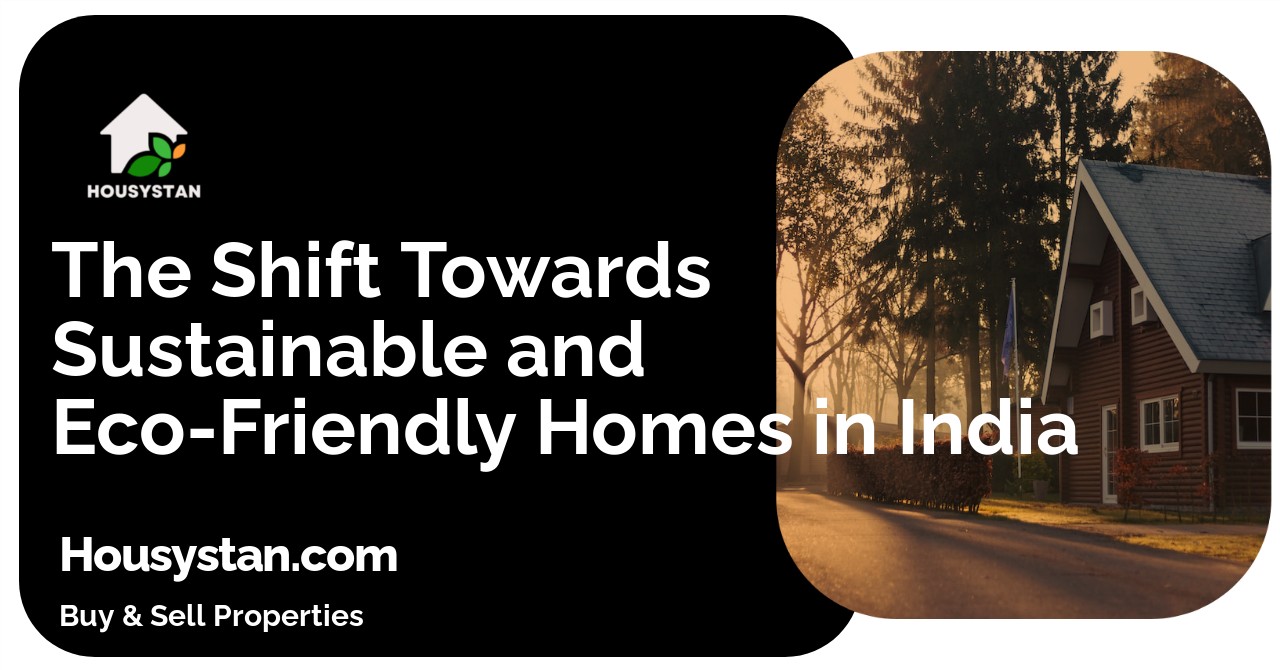The Shift Towards Sustainable and Eco-Friendly Homes in India
Read latest blogs and articles from Housystan

The Information mentioned here was last updated on:
21/12/2025The Shift Towards Sustainable and Eco-Friendly Homes in India
The growing awareness of environmental issues is changing the landscape of home construction and living in India. As people become more conscious of their environmental footprint, there is a significant shift towards sustainable and eco-friendly homes. This movement is not just about using eco-friendly materials; it's about creating homes that are energy-efficient, environmentally responsible, and resource-efficient. The following sections explore this shift in detail and provide insights into how it is transforming Indian living spaces.
What Makes a Home Sustainable?
- Verified Tenants/Buyers
- Unlimited Property Listing
- Zero subscription/charges fee
Understanding what constitutes a sustainable home is the first step in appreciating this shift. Sustainable homes are designed to have a reduced negative impact on the environment by efficiently using resources and reducing waste during construction and throughout the building's lifecycle.
- Energy Efficiency: One of the crucial aspects of sustainable homes is energy efficiency. This can include the use of solar panels, energy-efficient HVAC systems, and LED lighting.
- Water Conservation: Sustainable homes often incorporate rainwater harvesting, low-flow fixtures, and greywater systems to reduce water usage.
- Eco-Friendly Materials: Building with sustainable materials, such as reclaimed wood, bamboo, or recycled steel, is another hallmark of eco-friendly homes.
Why India is Embracing Eco-Friendly Homes
Several factors contribute to the growing trend of sustainable homes in India. These factors include environmental awareness, government policies, and the economic benefits associated with eco-friendly living.
Government Initiatives and Policies
The Indian government is playing a crucial role in promoting sustainable construction practices through various initiatives. For example, the introduction of the Green Building Certification System in India provides guidelines and incentives for developers to construct eco-friendly buildings.
Economic Benefits
Sustainable homes can offer significant cost savings in the long run. Lower energy bills, reduced water costs, and potential tax incentives make eco-friendly homes an economically attractive option for homeowners.
- Lower Utility Bills: Energy-efficient appliances and systems reduce monthly electricity and water expenses.
- Increased Property Value: Green certifications can increase property value, making these homes an appealing investment.
Social and Environmental Impact
The social and environmental benefits of sustainable living cannot be overlooked. By reducing carbon footprints, conserving water, and supporting healthier living environments, sustainable homes contribute to the overall well-being of communities.
Key Features of Eco-Friendly Homes in India
Eco-friendly homes include various features that enhance sustainability and livability. Below are some critical components commonly found in such homes:
Use of Renewable Energy
Incorporating renewable energy sources such as solar panels is a popular feature. Solar energy is abundant in India, and many homeowners capitalize on this by installing solar water heaters and photovoltaic panels to generate electricity.
Smart Home Technology
Smart home systems enhance energy efficiency by automating lighting, heating, and cooling, adapting to the homeowner's lifestyle, and reducing energy waste.
Sustainable Architecture and Design
The design of the home plays a vital role in its sustainability. Thoughtful architecture, such as maximizing natural light and ventilation, reduces dependency on artificial heating and lighting, lowering energy consumption.
Usage of Natural Materials
Builders are increasingly choosing natural materials, like adobe, rammed earth, and bamboo, which are sustainable and often locally sourced, reducing transportation emissions.
The Role of Builders and Developers
Builders and developers are crucial in driving the shift towards sustainable housing. Many are now incorporating green building techniques and materials into their projects. Additionally, some are obtaining green building certifications, such as IGBC (Indian Green Building Council) and GRIHA (Green Rating for Integrated Habitat Assessment), to demonstrate their commitment to sustainability.
Training and Education
Developers are also investing in training programs to educate their teams on sustainable building practices. This includes teaching workers about efficient construction methods, waste reduction, and the integration of renewable technologies.
Collaboration with Environmental Experts
Collaborating with environmental experts helps builders understand and implement the latest sustainable technologies and practices, ensuring their projects meet evolving eco-friendly standards.
The Consumer Shift
Indian consumers are becoming more environmentally conscious, which influences their buying decisions. Buyers now seek homes that not only offer modern amenities but also align with their values of sustainability and environmental responsibility.
Changing Lifestyle Preferences
There is a noticeable trend towards minimalistic living, which is intrinsically eco-friendly. People are opting for smaller homes that require fewer resources to build and maintain, contributing to the overall sustainability of their living situation.
Awareness and Education
Increased access to information is making consumers more aware of the environmental impact of their homes and the benefits of sustainable living. Homebuyers often consider the long-term benefits of eco-friendly homes over traditional options.
Overcoming Challenges in Sustainable Housing
While the shift towards sustainable homes is promising, there are challenges to overcome. These include higher upfront costs, limited awareness in some regions, and the slow adoption of technology.
Cost and Economic Barriers
The initial cost of building an eco-friendly home can be higher than traditional homes, primarily due to the cost of materials and technology. However, the reduction in operating costs over time often offsets this.
Technological Adoption
The adoption of new technologies can be slow due to a lack of infrastructure and expertise in some areas. To accelerate this process, there is a need for government and private sector collaboration to invest in technology and training.
Awareness and Cultural Shifts
In regions where awareness is limited, cultural shifts towards eco-friendliness may take time. Educational campaigns and government initiatives can play a crucial role in changing public perception and encouraging sustainable practices.
The Future of Sustainable Homes in India
The future of sustainable housing in India is bright, with growing governmental support, increasing consumer demand, and advancing technology driving the movement forward. As India continues to urbanize rapidly, the focus on building eco-friendly and sustainable living spaces will be essential to addressing environmental challenges and promoting a healthier lifestyle for future generations.